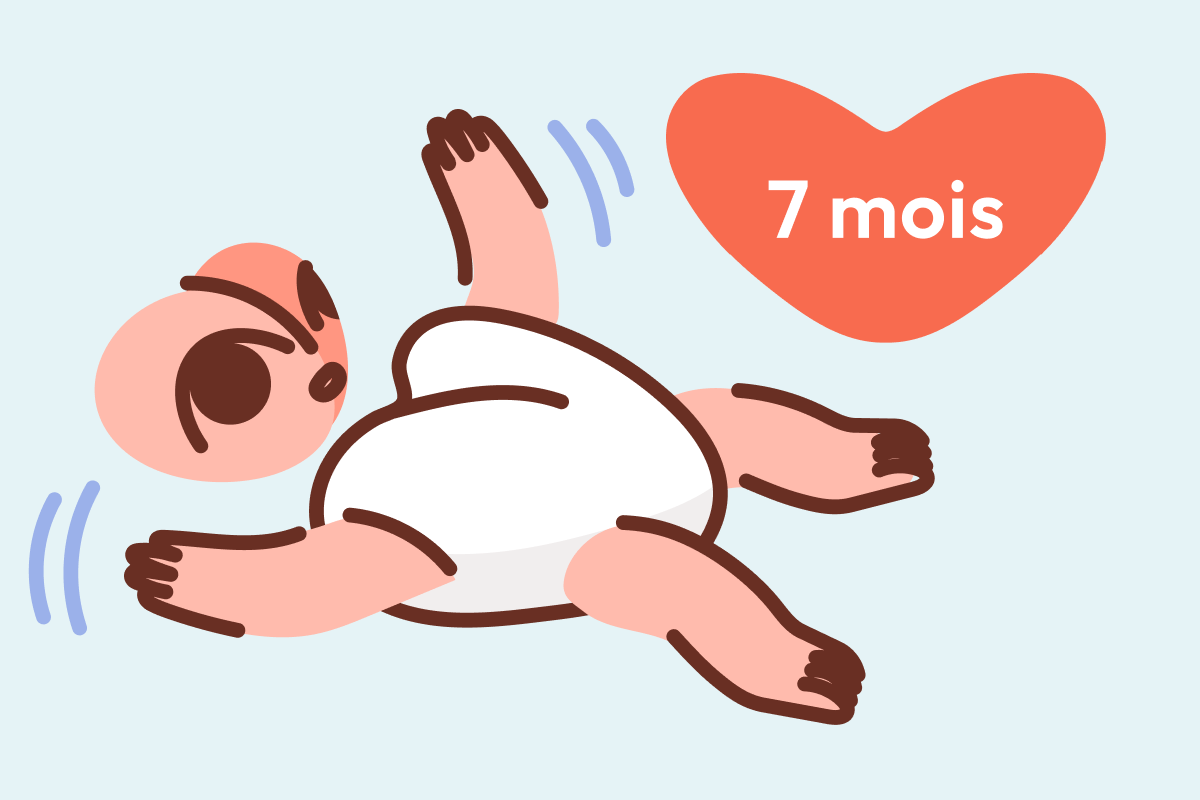Witnessing your 7 month old baby surge with newfound curiosity can trigger a blend of awe and apprehension. Are you quietly tallying developmental leaps? Wondering if night waking is tied to teething or simply a fleeting phase? The landscape at this age is dynamic—brimming with transformation in motor skills, evolving nutritional needs, and new social signals. So many questions swirl: is your baby eating enough? Is that cough ordinary, or worth a prompt call to the pediatrician? Together, let’s explore not just what science delineates for a 7 month old baby, but also the daily realities parents face, from sleep dilemmas to joyful shrieks and everything between. Expect in-depth guidance on sleep, nutrition, developmental signs, play, and safety—layered with trusted medical insight and reassurance.
Physical Growth and Teething: The Transformation Unfolds
Growth may slow after the six-month mark, yet your 7 month old baby continues along their unique growth trajectory. Pediatric charts aren’t absolutes. Average weight gain lands between 90–120g per week, though fluctuations are normal. Plotting your child’s measurements along their own curve is more meaningful than comparing numbers with others. Parents often wonder, is my 7 month old baby big enough, or too small? If persistent doubts arise, your pediatrician is the prime resource for tailored assessment.
Teething often arrives with a flourish at this stage. Have you noticed puddles of drool or the relentless gnawing on every toy within reach? The eruption of those primary incisors, frequently heralded by flushed cheeks and low-grade fever, can disrupt both mood and sleep. Refrigerated teething rings and gentle gum massages (clean hands, always) may provide comfort. Not all babies exhibit the classic symptoms—some sail through, unfazed.
Gross Motor Skills: Moving Toward Independence
Marvel as your 7 month old baby gains mastery over large, purposeful movements—the foundation for future mobility. Many will remain in a sitting posture, unsupported, hands free to grab at blocks or participate in cause-and-effect games. Rolling in both directions, pushing up onto hands and knees—perhaps even lurching into an early crawl—signal steady neuromuscular growth.
For parents, vigilance ramps up:
- Install soft play mats or foam tiles;
- Block stairs with sturdy gates (never trust a momentary distraction);
- Fit corner guards on coffee tables.
Supervised tummy time remains valuable for building upper body strength. Position toys at varying distances to encourage reaching, bridging the gap from passive observer to active explorer. What is considered “normal” for a 7 month old baby encompasses a wide range—some are commando crawling, while others prefer to pivot or belly-flop to traverse the living room.
Fine Motor Skills: Dexterity in Bloom
Finesse enters the picture as your baby actively refines the pincer grasp (thumb and forefinger in tandem, a detailed coordination marvel). This sets the stage for self-feeding, page turning in picture books, and endless fascination with the tiniest of objects. Offer textured toys with easy-to-grip surfaces to foster sensory development and hand-eye coordination. Sensory books with varied fabrics, soft blocks, and high-contrast objects enthrall the inquisitive mind of a 7 month old baby.
Monitor what enters their grasp: the increased ability to pick up small items brings the risk of choking. A quick household scan each day, removing buttons, coins, and other hazards, becomes second nature.
Language and Early Communication: Foundations for Expression
This period brims with tantalizing vocal experimentation. Babbling takes center stage, punctuated by chains of “ba-ba,” “da-da,” and “ma-ma.” (Spoiler: at first, these syllables carry no meaning.) Respond by echoing sounds, verbalizing actions, and narrating daily life—a proven catalyst for language wiring. Eye contact, smiles, and reciprocal babbling strengthen attachment and emotional security.
Could this be the start of real conversation? In a sense, yes. Communication precedes vocabulary. Watch for burgeoning gestures: waving, reaching for you, or imitating the rhythm of your voice. All of these are key social-emotional cues.
Cognitive Development: Recognition and Curiosity
A profound leap surfaces as your 7 month old baby grasps the concept of object permanence—the understanding that objects persist even when hidden. Games like peekaboo become riveting, deeply satisfying, and not just entertaining. What appears as simple amusement is actually a workout for memory and problem-solving circuits.
You might also observe keen interest in familiar faces and voices, with more pronounced reactions to strangers or separation—setting the groundwork for social referencing and attachment. Exploring safe everyday objects—different household items, for example—can enrich sensory learning.
Social and Emotional Development: Bonding and Trust
Your baby’s world revolves less around reflex and more around intentional, nuanced social response. Recognition of caregivers, enthusiastic smiles, laughter in response to silly faces—these all spotlight the emerging social brain. If separation anxiety emerges (resistance when you leave, clinginess, tears), treat it as evidence of healthy attachment rather than a problem to be solved. Predictable routines and gentle goodbyes help build long-term emotional regulation.
Warning Signs: When to Consult the Pediatrician
Should parents worry if milestones aren’t met precisely? Mostly, no—variation is typical. However, certain signs merit evaluation:
- Absence of eye contact or response to voices;
- Inability to roll or sit with support;
- No transfer of objects hand-to-hand;
- Minimal babbling or lack of vocalization.
Any parent noticing these should seek a medical opinion. Pediatricians can provide formal evaluation, often using developmental screening tools to tailor interventions if needed.
Sleep Rhythms: Needs, Routines, and Safety
A 7 month old baby commonly sleeps 12–15 hours across 24 hours (including two or three daytime naps). Yes, sleep regression—night waking, restlessness, difficulty settling—may hit, linked to teething, motor surges, or emotional milestones. Adjust nap schedules if needed, and embrace consistent bedtime rituals. Consider:
- Warm bath, gentle massage (using unscented moisturizer),
- Dimmed lights,
- Quiet storytelling or lullabies.
To reduce risk of sudden infant death syndrome (SIDS), always place baby on their back, use a firm mattress, and clear the sleep area of soft items, toys, or cords. Room sharing (not bed sharing) is the safest arrangement according to leading medical bodies. Lower crib mattresses promptly as soon as your baby pulls to stand.
Feeding and Nutrition: Laying the Foundation
By seven months, breast milk or infant formula still provides the majority of essential nutrients—calcium, protein, vitamins A/D/E, and antibodies. Most babies take between 17–27 ounces (500–800 ml) daily, guided by hunger cues rather than strict schedules. Solid foods—pureed vegetables (think: carrots, green beans), mashed fruits (pears, apples), and rice cereal—become regular components at breakfast, lunch, or dinner.
Introduce one new food at a time (wait 3–5 days before adding another). This cautious approach aids in identifying allergic reactions; look for skin changes or digestive upset, and check with your doctor at the first sign of concern. Avoid honey, cow’s milk as a drink (yogurt and cheese are exceptions), whole or chopped nuts, and hard fruits or vegetables that pose a choking hazard.
Hydration: Supporting Growth and Well-being
Solid foods introduce slightly increased water requirements, but breast milk or formula remains the prime source of hydration. Offer 100–200 ml (roughly 3–7 ounces) of water across meals, preferably in a sippy cup to encourage developing independence. Watch for dehydration signs—fewer than four wet diapers in 24 hours or a dry mouth signal the need for extra fluids, especially during illnesses or heat waves. Seek medical attention if you suspect persistent dehydration or illness.
Play and Activity: Stimulate, Engage, Delight
Underpinning robust development is stimulation—delivered not in rigid lessons, but through joyful, interactive play. Alternate periods of independent exploration with shared games:
- Soft-block towers for fine motor challenge,
- Sensory books to ignite curiosity,
- Hide-and-seek with favorite toys (bolstering memory and object permanence).
Rhythmic songs with hand gestures, facial mimicry, and leaving space for your baby to “respond” fuels language pathways. Use mirrors for early self-recognition and a glimpse into developing identity. Intersperse play with quiet, reflective moments—the signs of fatigue (rubbing eyes, crankiness) should signal a pause, not a push for more.
Home Safety: Anticipate, Minimize, Supervise
With increased mobility comes novel hazards. Anchor furniture, supervise on raised surfaces, stash small items above baby’s reach, and secure cleaning products and medications. Safety gates, window locks, electrical outlet covers—these mitigate preventable injuries.
Falls and bruises are, at times, spectators to active discovery. For minor bumps, a cool compress suffices; any concerning symptoms (loss of consciousness, persistent vomiting, or unusual drowsiness) demand immediate medical attention.
Skin, Fever, and Oral Health: Everyday Care Details
Skin at this age remains fragile—prone to dryness or diaper rash, particularly during teething or gastroenteritis. Bathe gently, avoid daily soaps, and apply fragrance-free moisturizer. Barrier cream protects delicate skin from moisture.
Fever: a defense mechanism often triggered by minor infections, teething, or routine illnesses. A digital rectal thermometer offers precise readings; fever below 38°C (100.4°F) without distress is rarely dangerous. Seek prompt medical advice if fever persists beyond 48 hours, is accompanied by convulsions, vomiting, or labored breathing.
With the arrival of teeth, start brushing with a soft baby toothbrush and a trace of water—establishing a healthy oral routine early prevents dental issues later.
Vaccinations and Checkups: Nurturing Long-term Health
Routine pediatric appointments support the overall continuity of growth and development. Vaccinations as recommended by official guidelines safeguard against serious diseases, contributing not only to your own child’s well-being but also community protection. If ever uncertain about timing or reactions as your 7 month old baby receives immunizations, raise your questions openly with your healthcare provider.
Parental Well-Being and Support
Fatigue, self-doubt, or parental anxiety often peak along with new stages of independence and sleep disruption. Tempting though it may be to prioritize baby’s needs around the clock, parental self-care is not a luxury but a necessity. Rest when possible, eat regularly, and don’t hesitate to seek support—whether practical advice from other families, or expert input from child health professionals. You are your baby’s greatest resource, and your calm presence does more than you realize.
Above all, celebrate every accomplishment—rolling, babbling, that first hesitant bite of mashed banana. Your delight and encouragement foster not just skills, but confidence and a deep sense of security in your 7 month old baby.
Key Takeaways
- A 7 month old baby flourishes within a wide spectrum of normal development. Chart milestones, watch progress—but avoid stress over small differences.
- Continue breast milk or formula as the primary nutrition, with solid foods introduced gradually and with attention to signs of intolerance or allergy.
- Ensure home safety by babyproofing and maintaining vigilance during increased mobility. Supervise all meals to prevent choking.
- Play, language stimulation, and gentle routines nurture cognitive, motor, and emotional growth. Interactive, responsive parenting is a powerful incubator.
- Prioritize both baby’s and your own health—consult professionals as needed, and remember, your instincts are valuable.
- Access tailored resources and expert support for ongoing questions and reassurance by downloading the Heloa application, offering personalized advice and free health questionnaires for children.
Parenting a 7 month old baby is an evolving adventure; each milestone reflects your nurturing, patience, and the remarkable capacities of your growing child.
Questions Parents Ask
What activities can help stimulate my 7 month old’s development?
Everyday play can have a big impact on your baby’s growth. Encourage curiosity by offering different textures and safe household objects to explore. Singing songs, making gentle funny faces, or reading together capture your baby’s attention and support language development. Games like peekaboo not only entertain, they also help with memory by reinforcing object permanence. Giving your baby time on the floor—supervised, of course—to reach, roll, or crawl fosters both motor skills and confidence. Remember, at this age, your involvement and presence make every activity even more enriching.
Is it normal for my 7 month old to not crawl yet?
Many parents wonder about this, but there is a wide range of normal when it comes to mobility at 7 months. Some babies prefer to roll or pivot before they master crawling, while others might focus on sitting or exploring objects with their hands. Not crawling at 7 months is usually just a variation in development—not a concern. Most children eventually find their own way of moving, and often crawl later or even skip crawling altogether. What matters most is continued progress in strength, movement, and curiosity. If you notice your baby isn’t making any attempts to move or seems uncomfortable, discussing it with a healthcare professional can offer extra reassurance.
Should my 7 month old be saying words?
At 7 months, babies are often busy experimenting with sounds and babbling, but forming clear words isn’t expected yet. Repetitive syllables like “ba-ba”, “da-da”, or “ma-ma” are common, though at this stage, these sounds usually aren’t linked to meaning. The path to first real words often stretches into the coming months. Continue responding to your baby’s sounds, talking about what you’re doing, and enjoying “conversations” together. This warm, interactive communication supports future language and makes your baby feel valued and understood.

Further reading:









